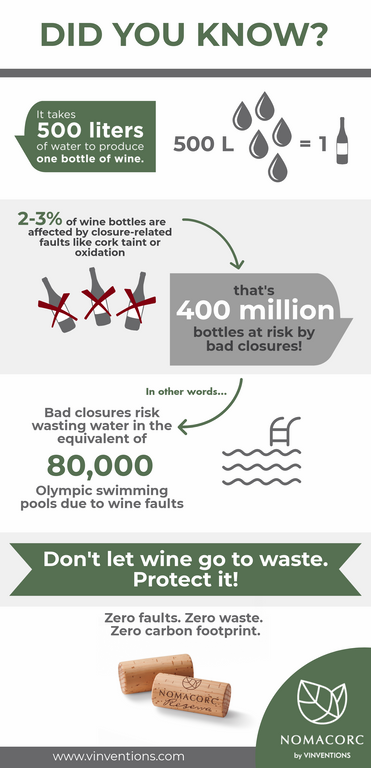Understanding the Environmental Impact of Closure-Related Faults: Water
– By Mel Cressman
This is part of a larger series of infographics on sustainability and the impact of closure-related wine faults.
Sustainability is a vital aspect of the wine industry: Environmentally, the production of wine requires the continuous utilization and renewal of natural resources, and economically, wineries must ensure that their businesses can prosper and produce year after year. Wineries are becoming more sustainable and environmentally conscious, and as part of this positive trend, look to their means of production and bottling to accomplish their sustainable visions.
When it comes to wine packaging, there are a few ways to proactively manage your environmental contributions. Specifically, one contributor to controlling sustainability is the wine bottle’s closure—seemingly small and often overlooked (except for when it fails), the closure can make or break the wine.
REDUCING WASTE, GAINING CLOSURE
Did you know that wine faults caused by closures not only negatively affect the bottle of wine, but the environment as well? Each year, nearly 400 million bottles of wine worldwide are impacted by bad closures with things like cork taint (TCA), oxidation, or reduction.
That’s a lot of wine to waste!
However, it’s not just the wine that is lost—precious resources like water are wasted when closures ruin the wine, too. For example, those 400 million faulty bottles expended about 200 billion liters of water during production—which is the equivalent of about 80,000 Olympic-sized swimming pools of wasted water if the wine is bad!
We hate to see wine go to waste when closures don’t do their job properly. Luckily, wines sealed with the Nomacorc Green Line don’t have to worry about faults—they’re guaranteed TCA-free and glue-free, and allow consistent oxygen management and reliable protection to guard against other closure-related faults like oxidation and reduction.

For more information on our zero carbon footprint closures and the Green Line, click here.
